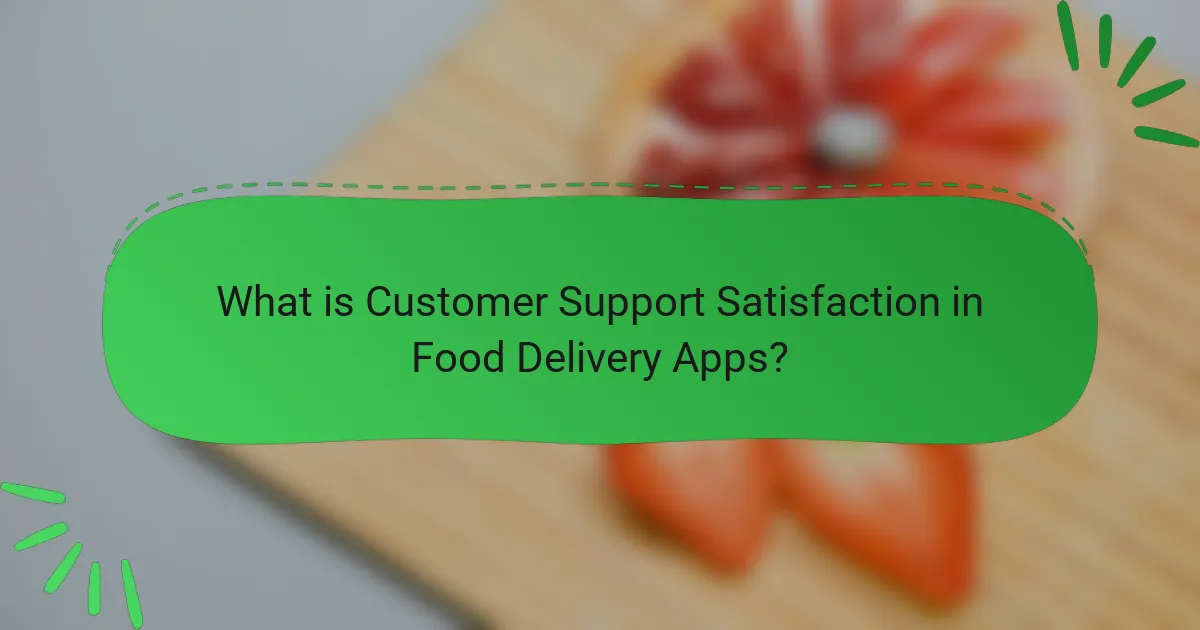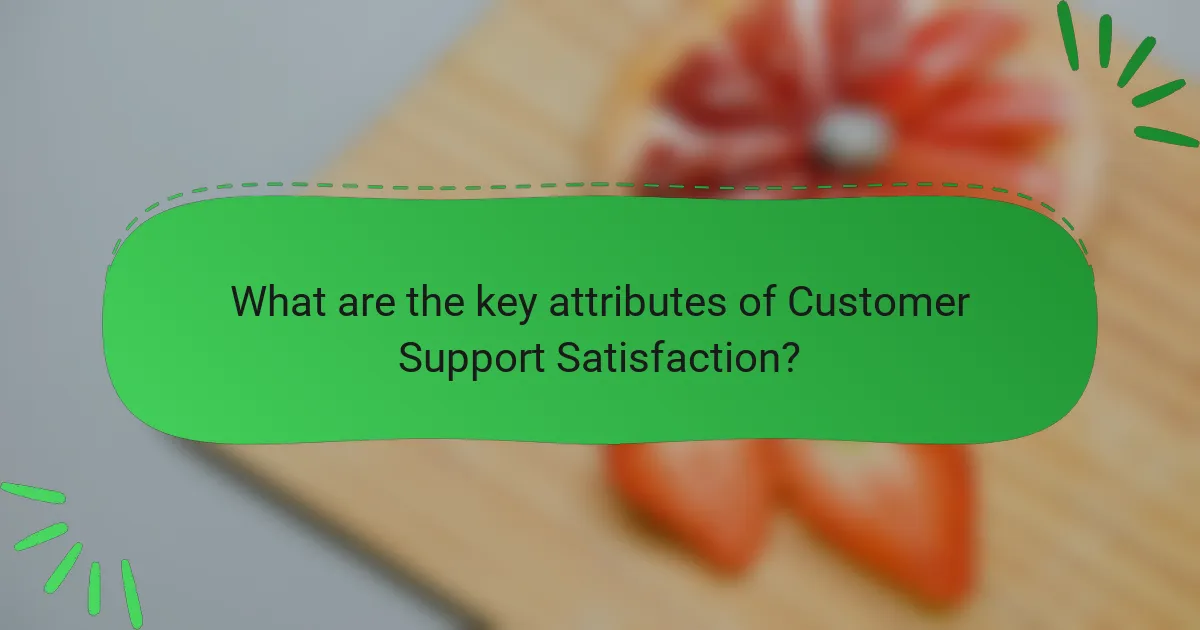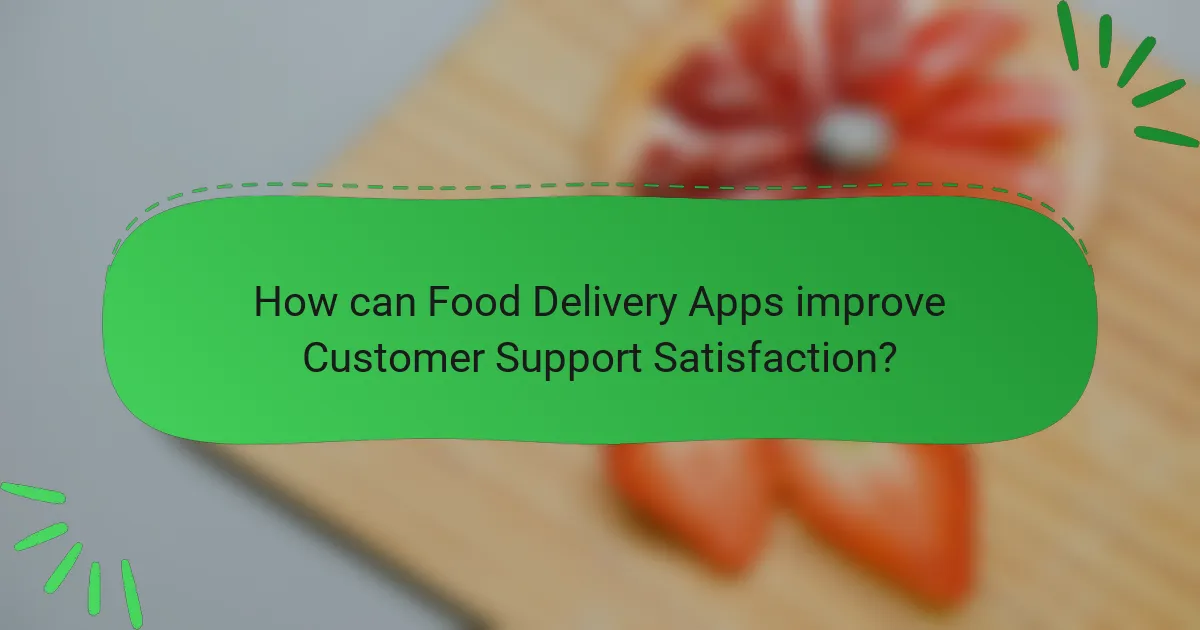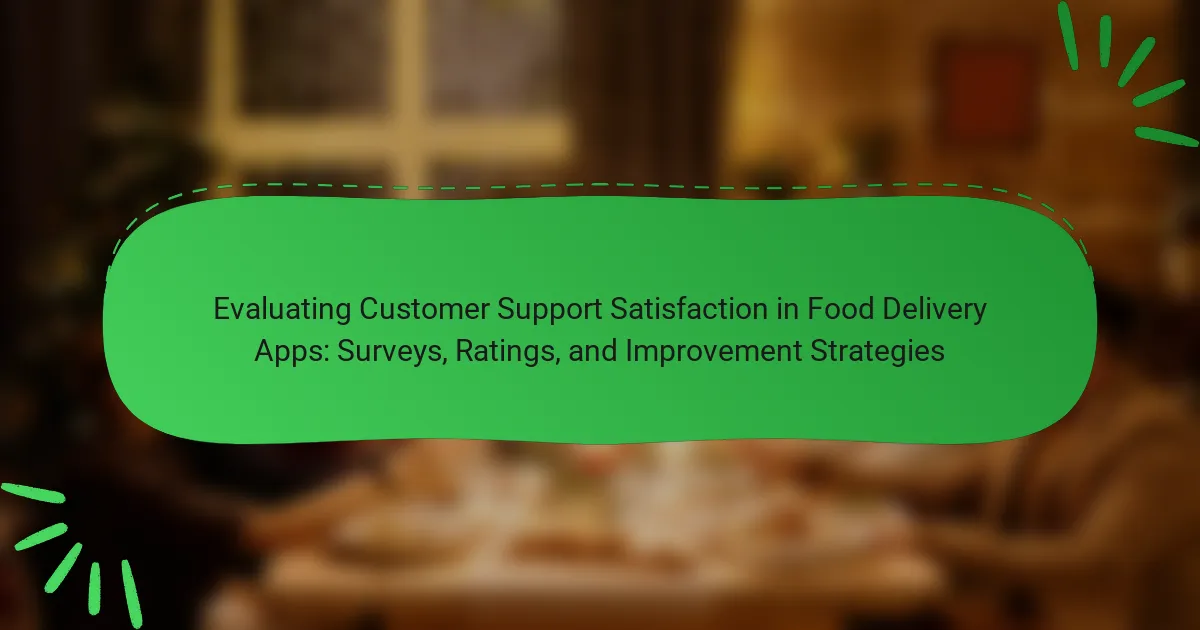Customer support satisfaction in food delivery apps is a critical factor influencing user retention and repeat business. It encompasses essential attributes such as response time, resolution effectiveness, communication clarity, and customer empathy. High customer support satisfaction is linked to increased spending, with studies indicating that 70% of customers prefer companies that offer excellent service. The article evaluates the current state of customer support in food delivery apps, highlights key metrics from surveys and research, and discusses strategies for improvement, including enhancing response times and providing personalized assistance. By focusing on these elements, food delivery services can significantly boost customer satisfaction and loyalty.

What is Customer Support Satisfaction in Food Delivery Apps?
Customer support satisfaction in food delivery apps refers to the level of contentment users feel regarding the assistance provided by these services. It encompasses factors such as response time, issue resolution effectiveness, and overall user experience during interactions. High customer support satisfaction is crucial for retaining users and encouraging repeat business. Studies show that 70% of customers are willing to spend more with companies that provide excellent customer service. Additionally, a survey by Zendesk indicated that 87% of customers believe that a positive customer service experience influences their purchase decisions.
How is Customer Support Satisfaction measured in this context?
Customer Support Satisfaction in food delivery apps is measured through surveys and ratings. Users provide feedback on their experiences after interacting with customer support. Surveys typically include questions about response time, issue resolution, and overall satisfaction. Ratings are often given on a scale, such as 1 to 5 stars. Both methods enable companies to quantify customer satisfaction levels. Analyzing this data helps identify areas for improvement. Regular assessment of customer feedback ensures that support services meet user expectations. Research shows that 70% of users prefer rating systems for quick feedback.
What types of surveys are commonly used to assess satisfaction?
Common types of surveys used to assess satisfaction include customer satisfaction surveys, Net Promoter Score (NPS) surveys, and service quality surveys. Customer satisfaction surveys typically ask users to rate their overall experience. NPS surveys measure the likelihood of customers recommending a service. Service quality surveys evaluate specific aspects of service delivery, such as responsiveness and reliability. Each survey type provides valuable insights into customer perceptions. Research shows that regular use of these surveys can lead to improved customer retention and loyalty.
How do ratings influence perceptions of customer support?
Ratings significantly influence perceptions of customer support. High ratings typically indicate positive experiences, leading customers to view the support as reliable and effective. Conversely, low ratings suggest poor service quality, resulting in distrust and negative expectations. Research shows that 70% of consumers trust online reviews as much as personal recommendations. This trust extends to customer support ratings, shaping beliefs about a company’s responsiveness and helpfulness. Ratings serve as a quick reference for potential customers, impacting their decisions to engage with a service. Higher-rated support can enhance brand loyalty, while lower ratings can drive customers to competitors.
Why is Customer Support Satisfaction important for Food Delivery Apps?
Customer support satisfaction is crucial for food delivery apps because it directly impacts customer retention and loyalty. High satisfaction levels lead to repeat usage of the app. According to a study by Zendesk, 87% of customers are willing to pay more for better customer service. Effective support can resolve issues quickly, enhancing the overall user experience. Positive interactions encourage customers to leave favorable reviews and ratings. This, in turn, attracts new users and boosts the app’s reputation. Additionally, satisfied customers are more likely to recommend the service to others. Therefore, prioritizing customer support satisfaction is essential for the growth and success of food delivery apps.
What impact does customer satisfaction have on user retention?
Customer satisfaction significantly impacts user retention. High levels of satisfaction lead to increased loyalty among users. Satisfied customers are more likely to continue using a service. Studies show that a 5% increase in customer retention can increase profits by 25% to 95%. In the food delivery app sector, positive experiences can lead to repeat orders. Conversely, low satisfaction can result in users switching to competitors. Research indicates that 70% of customers who experience poor service will abandon a brand. Thus, maintaining high customer satisfaction is crucial for retaining users in food delivery apps.
How does satisfaction correlate with overall app performance?
Satisfaction correlates positively with overall app performance. Higher user satisfaction often leads to increased app usage and retention. Users who report satisfaction tend to rate app performance favorably. Studies show that a 1-point increase in satisfaction ratings can lead to a 10-20% increase in user engagement. Additionally, satisfied users are more likely to recommend the app to others. This word-of-mouth can further enhance the app’s performance in the market. Research indicates that food delivery apps with higher satisfaction scores experience lower churn rates. Therefore, improving customer support can significantly enhance overall app performance.

What are the key attributes of Customer Support Satisfaction?
Key attributes of Customer Support Satisfaction include response time, resolution effectiveness, communication clarity, and customer empathy. Response time measures how quickly support addresses inquiries. Research indicates that 82% of customers expect a response within 10 minutes. Resolution effectiveness assesses whether issues are resolved satisfactorily. Studies show that 70% of customers prefer a single interaction to solve their problems. Communication clarity evaluates how well support conveys information. Clear communication reduces misunderstandings and improves customer trust. Customer empathy refers to the ability of support agents to understand and relate to customer feelings. Empathetic support can enhance customer loyalty and satisfaction significantly.
Which factors contribute to a positive customer support experience?
Effective communication contributes to a positive customer support experience. Clear and concise information helps customers understand solutions. Timely responses are crucial; studies show that quick replies increase customer satisfaction. Empathy in interactions builds rapport and trust with customers. Knowledgeable support agents provide accurate solutions, enhancing the overall experience. Personalization in responses makes customers feel valued and understood. Consistent follow-ups ensure issues are resolved completely, leading to higher satisfaction rates. These factors collectively foster a positive customer support environment.
How do response times affect customer satisfaction?
Response times significantly impact customer satisfaction. Faster response times generally lead to higher satisfaction levels. Customers appreciate timely assistance, which fosters a sense of value. Research indicates that 70% of customers prefer immediate responses to inquiries. Delays can result in frustration and negative perceptions of service quality. A study by Microsoft found that 61% of consumers expect a response within one hour. Therefore, optimizing response times is crucial for enhancing customer satisfaction in food delivery apps.
What role does the quality of communication play?
The quality of communication plays a crucial role in customer support satisfaction. Effective communication enhances customer experience and builds trust. Clear information reduces misunderstandings and resolves issues promptly. According to a study by the Harvard Business Review, 70% of customers value communication quality in service interactions. High-quality communication leads to higher customer retention and loyalty. In food delivery apps, timely updates and transparent responses are essential. This results in improved ratings and overall satisfaction.
What unique challenges do Food Delivery Apps face in customer support?
Food delivery apps face unique challenges in customer support due to the complexity of their operations. These apps must manage real-time interactions between customers, restaurants, and delivery personnel. Communication issues often arise from language barriers and differing expectations. High order volumes can lead to overwhelmed support teams, resulting in longer response times. Additionally, technical glitches can complicate order tracking and processing. Customers frequently express frustration over missing items or delays, which adds pressure to resolve issues quickly. According to a 2022 survey by Statista, 67% of users reported dissatisfaction with the speed of customer support responses in food delivery services. This data highlights the need for effective solutions in customer support strategies.
How do high order volumes impact support quality?
High order volumes negatively impact support quality. Increased order volumes can overwhelm support teams. This leads to longer response times for customer inquiries. Customers may experience frustration due to delays in assistance. A study by Zendesk found that 70% of customers value quick responses. When support is inundated, agents may rush interactions. This can result in unresolved issues and lower customer satisfaction. Ultimately, high order volumes strain resources, degrading the overall support experience.
What are common customer complaints in food delivery services?
Common customer complaints in food delivery services include late deliveries, incorrect orders, and poor food quality. Late deliveries often frustrate customers, especially when they are waiting for meals during specific times. Incorrect orders can lead to dissatisfaction when customers receive the wrong items or missing items. Poor food quality is a significant concern, as customers expect fresh and well-prepared meals. Additionally, unresponsive customer service can exacerbate these issues, leaving customers feeling neglected. According to a survey by Statista, 27% of users reported dissatisfaction with delivery times as a major complaint.

How can Food Delivery Apps improve Customer Support Satisfaction?
Food delivery apps can improve customer support satisfaction by enhancing response times and providing personalized assistance. Quick responses to customer inquiries lead to higher satisfaction rates. Research shows that 80% of consumers expect immediate responses from customer service. Implementing chatbots for initial inquiries can streamline the process. Additionally, training support staff to handle complex issues effectively increases resolution rates. A study by Zendesk found that 69% of consumers prefer live chat support. Offering multiple communication channels, like phone, email, and chat, caters to diverse customer preferences. Regularly gathering customer feedback helps identify areas for improvement. This proactive approach fosters a positive customer experience.
What strategies can be implemented to enhance customer support?
Implementing a multi-channel support system enhances customer support. This strategy allows customers to reach out via their preferred platforms, such as chat, email, or phone. Training staff in empathy and problem-solving skills improves interaction quality. Quick response times are crucial; studies show that 60% of customers expect a reply within an hour. Regularly gathering customer feedback helps identify areas for improvement. Using analytics to track support performance can reveal trends and issues. Additionally, creating a comprehensive knowledge base enables self-service options for customers. These strategies collectively lead to higher customer satisfaction and loyalty.
How can technology be leveraged to improve response times?
Technology can be leveraged to improve response times by implementing real-time communication tools. These tools allow customer support representatives to engage with customers instantly. Chatbots can handle initial inquiries, providing immediate responses. This reduces wait times for customers seeking assistance. Additionally, integrating customer relationship management (CRM) systems streamlines information access. Representatives can quickly retrieve customer data, enhancing response efficiency. Data analytics can identify peak inquiry times, allowing for better resource allocation. According to a study by Zendesk, businesses using real-time chat tools see a 40% increase in customer satisfaction. Implementing these technologies leads to faster and more effective customer support.
What training programs can help support staff deliver better service?
Customer service training programs can significantly enhance staff performance. Programs such as customer service excellence training focus on communication skills. These programs teach staff how to effectively address customer inquiries. Role-playing scenarios are often included to simulate real-life situations. Another program, conflict resolution training, equips staff to handle difficult interactions. This training helps in de-escalating potential issues with customers. Additionally, product knowledge training ensures staff are well-informed about offerings. This knowledge enables them to provide accurate information to customers. Research indicates that companies with robust training programs see a 24% higher customer satisfaction rate.
What best practices should Food Delivery Apps follow for surveys and ratings?
Food delivery apps should implement clear and concise surveys to gather customer feedback effectively. Surveys should include specific questions about the delivery experience. This allows customers to provide targeted feedback. Rating systems should be simple, using a scale that is easy to understand. A common approach is a 1 to 5-star rating system.
Apps should ensure surveys are sent promptly after delivery. This timing increases the likelihood of receiving accurate feedback. Additionally, offering incentives for completing surveys can boost participation rates. Data from a survey by ReviewTrackers indicates that 70% of customers are more likely to leave feedback if incentivized.
Lastly, food delivery apps should analyze survey results regularly. This analysis helps identify trends and areas for improvement. Implementing changes based on feedback can enhance overall customer satisfaction.
How can surveys be designed to yield actionable insights?
Surveys can be designed to yield actionable insights by incorporating clear, targeted questions. These questions should focus on specific aspects of customer experience. Use a mix of quantitative and qualitative formats to gather diverse data. Ensure questions are concise and easy to understand. Include rating scales to quantify responses effectively. Open-ended questions can provide deeper context and insights. Pre-testing surveys can help identify potential issues and improve clarity. Analyzing collected data through thematic analysis can reveal patterns and trends. Properly designed surveys can lead to meaningful improvements in customer support.
What are effective ways to encourage customers to leave ratings?
Effective ways to encourage customers to leave ratings include simplifying the rating process and providing incentives. A straightforward rating system increases the likelihood of participation. Customers appreciate ease of use, such as one-click ratings or star systems. Sending follow-up emails after service also prompts feedback. Research shows that personalized requests for ratings can lead to higher response rates. Offering discounts or rewards for leaving a rating can motivate customers further. According to a study by BrightLocal, 68% of consumers are likely to leave a review when asked. Engaging customers through social media can also enhance visibility and encourage ratings.
What are some common troubleshooting tips for improving customer support?
Common troubleshooting tips for improving customer support include enhancing communication channels, training staff effectively, and utilizing customer feedback. Clear communication channels like chat, email, and phone support allow customers to reach out easily. Staff training ensures representatives are knowledgeable about products and services. According to a study by Salesforce, 70% of customers say connected processes are very important to winning their business. Regularly collecting and analyzing customer feedback helps identify areas needing improvement. Implementing a robust ticketing system can also streamline issue resolution. Lastly, monitoring response times can highlight efficiency gaps in support processes.
Customer support satisfaction in food delivery apps is critical for user retention and loyalty, influenced by factors such as response time, issue resolution effectiveness, and communication quality. This article evaluates how customer satisfaction is measured through surveys and ratings, highlighting common types of surveys used and the impact of ratings on consumer perceptions. Additionally, it explores the importance of customer support satisfaction for food delivery apps, the unique challenges they face, and strategies for improvement, including training programs and technology utilization to enhance response times. Finally, best practices for designing effective surveys and encouraging customer feedback are discussed to provide actionable insights for enhancing support services.
